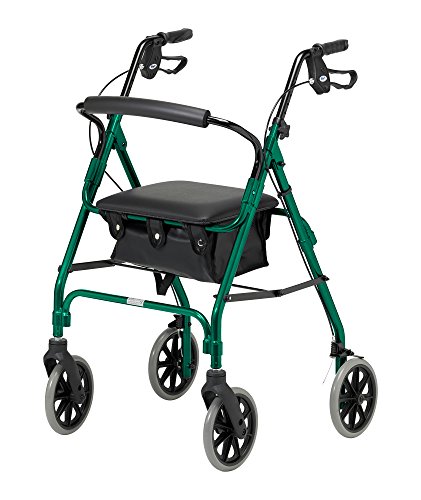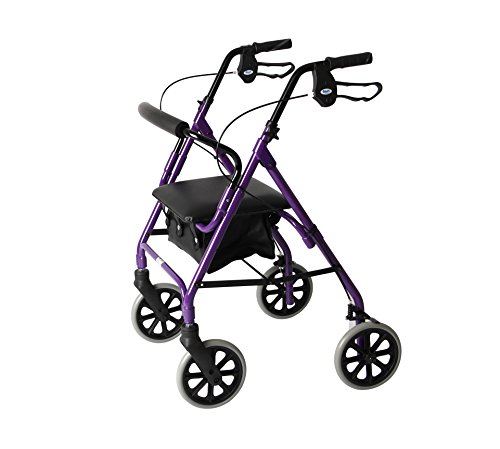Five Killer Quora Answers To Mobility Rollator
Curt
0
13
01.02 18:36
 Advantages of a Mobility purple rollator walker
Advantages of a Mobility purple rollator walkerWhen your loved one needs assistance walking, a mobility rollator can assist. These walking aids offer stability and enhance mobility with simple control and hand brake operation. They also have a seat for resting and storage options for items during longer trips.
 The best rollator wheelchair combo model to choose starts by identifying your personal preferences. These customizations, from frame materials to accessories for walker can make a significant difference in comfort and convenience.
The best rollator wheelchair combo model to choose starts by identifying your personal preferences. These customizations, from frame materials to accessories for walker can make a significant difference in comfort and convenience.Stability
The mobility rollator's stability is among its primary benefits. It's especially crucial for those with gait and balance problems. A mobility device provides an upright base that aids people maintain a healthy posture. This eases the pressure on joints like knee joints and the hips. It also increases the speed at which an individual can move.
The stability of a mobility device is due to its unique centre of gravity as well as the fact that all four wheels are in contact with the ground. This helps to prevent tipping over, which could be a common issue with other types of walking aid devices like transport chairs and wheelchairs.
To measure stability the instrumented Walker was modified to incorporate four single axis load cells (Futek LCM300, FUTEK Advanced Sensor Technology Inc. Irvine CA) and corresponding transmitters (Mantracourt T24-ACMi, Mantracourt Electronics Ltd, Exeter UK), as and a pressure-sensing insole system (Medilogic insole, T&T Medilogic Medizintechnik GmbH, Schonefeld Germany). The device was tested by 6 healthy participants doing various tasks that were that tested the stability of the user. The method used to spontaneously get up each 50mm step was recorded, along with the minimum stability margin ("SM"). To examine the impact of the task on SM the Friedman test and a least-squares regression model were applied.
To maximize the stability and safety of a rollator and walker, it is crucial that users stand straight in a good posture, and distribute their weight evenly on both handles. Ideally the hands and arms should be on the sides of the body, with the handles held in a loose manner. It is also important to keep the rollator near the body to ensure the highest stability. Additionally, people should never lean on the device with all their weight since this can create instability and increase the chance of falls.
Convenience
Rollators offer a stable platform to help users walk with ease. Their four wheels distribute weight evenly and permit more fluid movement than walkers that have only one front wheel. The handlebars enable the user to steer the rolling device while the hand brakes are used to stop it. Many models have built-in chairs that allow for rest or pauses during movements.
The key to a safe rollator is keeping a healthy posture and avoiding unbalanced movements. Keep your head straight and avoid hunching your shoulders and grasp the handles loosely. Your feet should be firmly planted with your toes pointing towards the front to encourage stability. You can also lock the hand brakes to help maintain an even pace and prevent abrupt stops that could strain muscles and cause discomfort.
A mobility rollator is an effective tool for those with limited mobility, or for those recovering from an injury that has caused them to feel weak or suffering from pain. It can help prevent accidents and minimize the effects of physical exercise on joints, muscles and ligaments.
Rollators usually come with a seat, and storage options. They are a great companion for people on the move. These features can help increase the level of independence of those who use them and make the device more functional for longer walks or trips over varied terrain.
Most rollators come with a padded seat that is located between the handlebars. They can also be folded for easy storage and transport. Many manufacturers offer additional storage options for their walkers, including bags, pouches, or tray that can be placed under the seat or along the frame.
These features can be especially useful for people who are not able or feel uncomfortable lifting their legs to stand when they want to rest or eat. Some models even come with a shopping basket to make it easier to collect groceries or personal items while traveling. To prevent interference when folding or operating the mobility rollator, make sure that any attachments or mods are compatible with your model.
Safety
When using a rollator it's important to be aware of the terrain as well as any other safety concerns. When walking with a lightweight rollator, keep it on the ground as much as possible and only raise it for obstacles or navigating through curbs and doors. Also, it's recommended to regularly clean and inspect the device to ensure it works properly and that there aren't any obstructions such as gravel or dirt which could cause it to sway out of control.
Rollator brake levers are usually designed to be broader than those on bicycles that makes it easier to use for those with weaker muscles in their hands or forearms. Many modern devices also come with tyres made of solid rubber instead of pneumatic ones which require inflation. This can decrease the risk of immobility and injury that can occur with punctures.
Consult a mobility specialist or physical therapist for guidance and instruction if you're not sure how to use your rolling device or what safety features you should look for in a new. They will recommend the most suitable model for you and give you advice on how to make the most of it.
It is also recommended to review the instruction manual that came with your rollator. It will contain important safety information and model-specific instructions. It is recommended to keep this manual in a safe location, such as the storage basket or compartment of your device, so it is always accessible. You can also locate additional resources on the internet by searching for communities committed to using mobility aids. You can also consult others who have used them for advice. It's also a good idea to participate in physical therapy services which can help you build strength and improve your balance and overall mobility. They can offer you an exercise program that is specifically designed to complement your rollator use. By improving your mobility you can more easily manage your daily tasks and lead a more independent life.
Customization
The right mobility device can improve the quality of living for people with impaired balance, coordination and strength. It can assist them in becoming more self-reliant and regain confidence in walking, even on longer excursions. It also helps reduce the time spent at home or resting due to mobility issues. This promotes healthy living and helps speed up recovery following surgery or injury. The wheels offer stability and mobility, and many models include a seat to provide comfort during long trips. Rollators come with a variety of storage compartments that allow users to carry their personal items. This allows them to be more independent and freedom of mobility.
Choosing the ideal mobility rollator involves evaluating factors like frame and seat specifications as well as weight capacity and wheel size relevant to different terrains. It is important to take into account the physical needs of the user, their height, and their lifestyle. Handles that can be adjusted, for example, allow users to find their ideal position for their hands and wrists, while a cushioned chair provides ease of use.
Other accessories like walker baskets or cup holders can enhance the convenience of mobility rollators and allow users to carry things without grabbing their hands. They can also be attached to the front of a rollator or under the seat.
The push-down brakes of a mobility rollator are a safe and easy way to stop and stop, with the user only having to lean down on the device to turn them off. This is especially helpful for those who are elderly or have trouble using levers. This allows them to avoid unnecessary stress on their joints. It is important to remember that the break-down mechanism on mobility devices can be engaged unintentionally if someone accidentally leans against the device. Therefore, it is recommended to select a model that has slow-down brakes to prevent this from happening.
Follow the manufacturer's recommendations and perform routine maintenance to extend the life of your mobility device. This includes cleaning the wheels and frame to prevent the build-up of dirt, checking the brakes for signs of wear and lubricating moving parts to ensure smooth operation.









